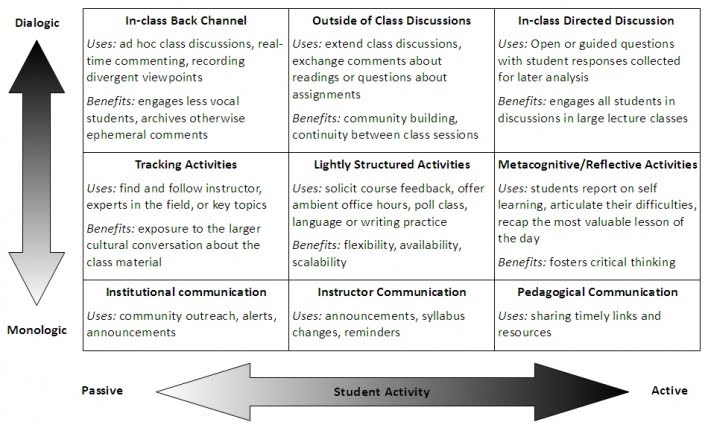
| Blog: | 6 mins | Task: | 15 mins |
Hopefully by now you are comfortable with Twitter basics and have explored a couple of tools and approaches to organising and curating content.
Along the way you will have undoubtedly seen great potential for developing a valuable network on the platform. Twitter is a community from which you can both draw and contribute knowledge and experience – not unlike how you might describe a university. In our final post, we provide an overview of some of the ways in which Twitter can be used for learning and teaching.
Learning and Teaching
There are a myriad of ways in which Twitter could be used within and alongside lectures or seminars, depending on your subject, topic and creativity. Dr Mark Sample, Associate Professor of Digital Studies at Davidson College, developed a framework for teaching with twitter which considers the level of interaction and activity required by the student.
The framework highlights the variation between using Twitter as a broadcasting medium and fully embracing it as a learning community. The vertical axis of the framework is a continuum of the conversation level required/generated by the type of use (from monologic to dialogic); the horizontal axis measures the level of student activity (from passive to active):
Students’ personal learning community
Establishing and encouraging the use of a module/programme/subject hashtag can facilitate student-student and student-tutor engagement amongst the cohort, outside of the formal setting. It also provides a convenient forum for resource-sharing and commentary, by both tutor and student. Even more valuable, it can offer the opportunity for students to interact with the actual subject of their studies, e.g. authors, companies, actors, educators etc. by tweeting questions directly to them.
The ‘Twessay’
Academics such as Donna M. Alexander have been using a pedagogical approach known as the ‘Twessay’ as a way to develop critical thinking skills and engage with the work of their peers via Twitter. Instead of writing a traditional essay, students are tasked with writing a tweet to demonstrate their understanding of a theme or topic. They can use images, links and hashtags but the idea is that they don’t use more than 140 characters to get their point across.
Livetweeting
On Day 7, we looked at how the hashtag is used for livetweeting conferences or CPD events. Educators have been using this approach for some time to enhance student engagement and build a classroom ‘backchannel’ for a module. Livetweeting can foster both a community discussion around the focus of a lecture, as well as enabling students to feed through questions or comments to the tutor – this is particularly useful in large lectures or for shy students.
Personal learning and reflective practice
As you continue to expand your personal learning network over the next few weeks, begin to compile a list of influential educational tweeters – both on pedagogy and your own subject area. Exposure to a larger network of educators results in new influences and should encourage reflection on your own methods. Lewis and Rush (2013) investigated the role of Twitter in initiating digital networks in Higher Education, finding it to be a valuable tool in the development of educational professionals and one possessing characteristics of a community of practice.
Complete an Activity!
We’d love to see some discussion on the #YSJ10DoT hashtag today around the following questions:
- do you currently use Twitter in teaching and/or for your own learning or research purposes?
- if not, would you consider using it? Why/Why not?
- in what way might you use it with your students?
Please attend our ‘Tweet-up’ on Friday, where you will hear how lecturers at York St John and the University of York use Twitter in a variety of ways to support learning and teaching.
That’s it! We hope you’ve enjoyed the ten days and have picked up some useful tips along the way. We’d like to thank everybody for their continued participation. We’re keen to hear your feedback and would be grateful if you could spare the time to complete the evaluation form we will circulate on Monday.
Further reading:
- Sue Beckingham’s Social Media for Learning blog
- UCISA: Social Media Toolkit: A Practical Guide to Achieving Benefits and Managing Risks
- Deborah Lupton (2014, University of Canberra). “Feeling Better Connected”: Academics’ Use of Social Media report.
| <<< Day 9: Retweeting | 10 Days of Twitter Introduction >>> |
Ten Days of Twitter for Learning Developers was originally adapted from a similar programme for STEM researchers, also created by Helen Webster. The materials are available under a Creative Commons license CC BY-NC-SA.

Ten Days of Twitter has been adapted by Technology Enhanced Learning for use at YSJ, and is licensed under a Creative Commons Attribution-NonCommercial-ShareAlike 4.0 Unported License.


0 responses on "Day 10 of #YSJ10DoT: Exploring Twitter for learning and teaching"